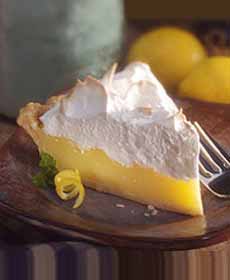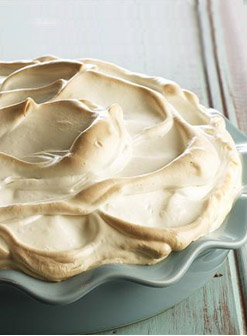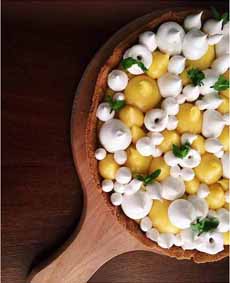TIP OF THE DAY: Lemon Meringue Pie & 25+ Recipes Beyond Pie
 [1] This American favorite originated in Switzerland (photo courtesy American Egg Board).
|
August 15th is National Lemon Meringue Pie Day. While meringue was perfected sometime in the 17th century, it took for the 19th century for the modern lemon meringue pie to appear, in Switzerland. Americans are happy about that: It’s always on the list of the Top 10 Favorite Pies. We’ll start today with the recipe for classic lemon meringue pie (photo #1). But here are creative variations: Lemon-flavored custards, puddings and pies date to Middle Ages, a time period of more than 1,000 years, from 476 C.E. to 1492 C.E. It was followed by the Renaissance, 1300 to 1600. Meringue was perfected sometime in the 1600s (the 17th century). The modern lemon meringue pie is a 19th-century recipe, attributed to Alexander Frehse, a Swiss baker from Romandy, the French-speaking part(s) of Switzerland. It combines a lemon custard single crust pie with meringue, the fluffy topping made from egg whites and sugar, baked on top. Here’s the classic lemon meringue pie recipe from McCormick. Thanks, Chef! |
|
|
PIE HISTORY The ancient Egyptians, who were great bread bakers, worked out the details of early pastry. Theirs was a savory pastry: a dough of flour and water paste to wrap around meat and soak up the juices as it cooked. Before the creation of baking pans in the 19th century, the coffin, as it was called (the word for a basket or box), was used to bake all food. Pastry was further developed in the Middle East and brought to Mediterranean Europe by the Muslims in the 7th century. Another leap occurred in the 11th Century, when Crusaders brought phyllo dough back to Northern Europe (the First Crusade was 1096 to 1099). Greek and Roman pastry did not progress as far as it could have because both cultures used oil, which can’t create a stiff pastry. In medieval Northern Europe, the traditional use of lard and butter instead of oil for cooking hastened the development of other pastry types. Pies developed, and the stiff pie pastry was used to provide a casing for the various fillings. By the 17th century, flaky and puff pastries were in use, developed by French and Italian Renaissance chefs. These pastry chefs began to make highly decorated pastry, working intricate patterns on the crusts. |
||




